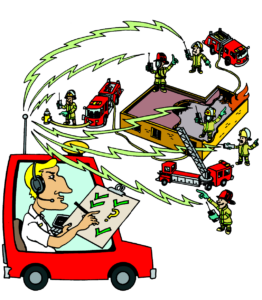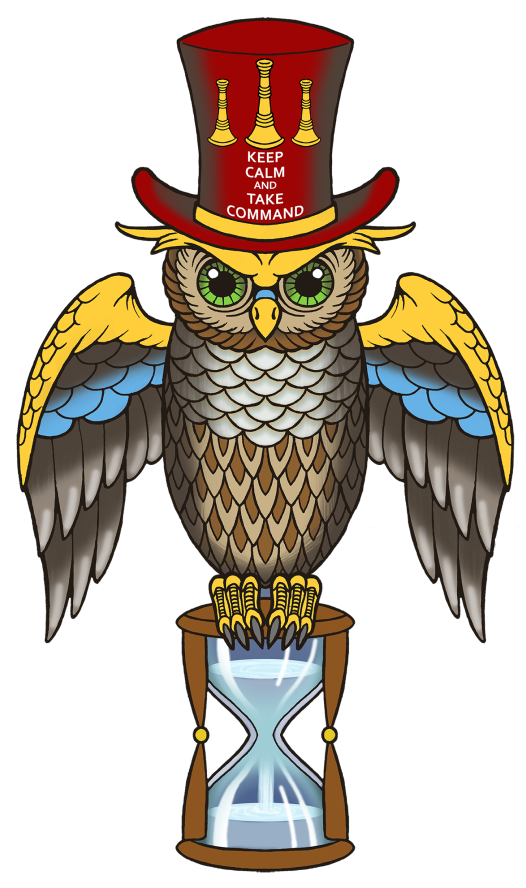From apprentice to master, the science, craft & art of incident command require experience, tacit knowledge & deliberate training
March 31, 2025Essential insights for mastering the art & science of incident command.
By Fire Chief Ed Hartin (ret.)
B Shifter Buckslip, April 1, 2025
What makes a competent incident commander? Think about the company officers and chiefs you have worked for. Which ones demonstrated competence in the role of C? What made them competent? Is this easy to describe, or is it like Supreme Court Justice Potter Steward’s characterization of pornography, “I know it when I see it”?
At a minimum, competent ICs should have sound foundational knowledge and skills and a deep understanding of fire behavior, building construction, strategy and tactics, and incident command. Cognitive psychologist Gary Klein, who pioneered the recognition-primed decision-making model, identified that ICs with expertise are skilled at recognizing critical cues (factors) and patterns that allow them to activate action scripts (standard actions), which are assessed using mental simulation and models.
Good ICs have experience, but not all experienced ICs demonstrate the same cognitive skills and expertise. How does an IC develop competence and become an expert in the science, craft and art of incident command?

The Importance of Why
In “Fire Protection: A complete Manual of the Organization, Machinery and Discipline of the Fire Brigade of London, Eyre Massey Shaw, chief of the London Fire Engine Establishment, emphasized that “In order to carry on our business properly, it is necessary for those who practice it to understand not only what they have to do, but why they have to do it. …”
One of the first steps in learning to be a competent IC is to watch the company and chief officers operating in that role. Some ICs provide a good example and others do not; we can learn from them both. Competent ICs recognize critical cues, anticipate developing conditions, identify plausible goals and workable tactical options, making timely and effective decisions. In addition, competent ICs maintain an effective command presence and effectively communicate tactical orders. Competent ICs maintain situational awareness through observation and by receiving reports on conditions, actions, and needs from operating companies. Observation of IC’s performance provides excellent cues to what competent incident commanders do but doesn’t answer the why (and in some cases the how) questions that help us develop the ability to think like an experienced IC.
Early in my career, after being blown out of a building by a backdraft, I was amazed that firefighters and officers who could tell me the signs of impending backdraft could not recognize the same conditions on the fireground. They had explicit knowledge but lacked the tacit knowledge to recognize this pattern of conditions.
The Type of Experience Matters
Most firefighters and officers would state that experience is essential to becoming a competent IC. Maybe it would be better to describe this as experiential learning—a learning style where people gain knowledge by doing, reflecting and engaging in hands-on activities that turn theory into real-world skills—because simply being there is not enough. Experience builds the ability to recognize important cues and patterns and identify when something is not quite right (anomalies). Recognizing patterns and anomalies are key elements of Dr. Gary Klein’s recognition-primed decision-making model, which was developed by studying experienced fireground commanders. However, it is important to remember the saying, “Experience is a hard teacher because the test is first and the lesson afterward!”
The Best ICs Develop Explicit & Tacit Knowledge
Explicit knowledge is information that can easily be explained, documented and shared, like facts in a book, presented in a lecture or an online learning environment. The development of explicit knowledge is important. Imagine functioning as an IC without understanding fire behavior, building construction and firefighting tactics. However, expertise also depends on tacit knowledge.
Tacit knowledge is a web of intuitive, instinctive and experiential insights. If IC No. 1 recognizes changing conditions and anticipates the potential for impending flashover, that is likely an application of their tacit knowledge to identify a pattern of conditions rather than a thoughtful analysis of the reasons for increasing smoke velocity, lowering neutral plane and darkening smoke color.
Training generally focuses on the transfer of important explicit knowledge, but the transfer of tacit knowledge presents a much greater challenge. Early in my career, after being blown out of a building by a backdraft, I was amazed that firefighters and officers who could tell me the signs of impending backdraft could not recognize the same conditions on the fireground. They had explicit knowledge but lacked the tacit knowledge to recognize this pattern of conditions.
Apprenticeship Paves the Path to Mastery
Historically, mastering an art or craft means having comprehensive knowledge, superior skills and the ability to teach others. An apprentice begins knowing nothing, watching and copying others. Once you have developed competence, the apprentice progresses to become a journeyperson. The origin of this designation dates to the Middle Ages when a journeyman would travel around the country working for different masters to further develop their expertise. When a journeyperson had demonstrated mastery to the current masters of their guild, they could take on apprentices and continue training others in their art or craft.
In his book, “Expert: Understanding the Path to Mastery,” Dr. Roger Kneebone uses the apprenticeship model to explain the process of becoming an expert in diverse disciplines ranging from tailoring to medicine.2 How does this apply to the fire service? Firefighters begin learning their craft in a probationary firefighter academy, gaining foundational knowledge and developing basic skills. They expand and refine their knowledge and skills when assigned to a fire company, working with and being mentored or coached by more senior members and their company officers.
When a person transitions from firefighter to company officer, they don’t start completely over, as they retain their task-level expertise as a supervisor, but they initially function at the apprentice level as an incident commander, developing expertise as IC No. 1. There is another great leap when a company officer transitions to the chief officer rank. The roles of a company officer and a chief officer on the fireground are significantly different. As IC No. 1, the company officer is the only person who must briefly operate at all three levels—strategic, tactical, and task. In contrast, chief officers may function at the tactical level as division or group supervisors or take on the strategic role of IC No. 2. The new chief officer also begins at the apprentice level, to some extent. Dr. Kneebone described his experience with this type of transition when he changed medical specialties from being a trauma surgeon in South Africa to being a general practitioner in England. While he was still qualified as a doctor, the requisite knowledge, skills and focus of his work were quite different.
Simple Tips for Developing Expertise
As an IC, progression through the three levels of competence—apprentice, journeyperson and master—requires focused effort to gain the explicit and tacit knowledge needed to develop expertise. Traveling this road involves integrating formal training to gain the necessary explicit knowledge and a concerted effort to build tacit knowledge. This requires personal experience as an IC and learning from ICs with higher levels of expertise, focusing on what they do and how and why.
Where are you in your development as an IC: apprentice, journeyperson, or master? What are you doing to increase your mastery (regardless of your level)? If you are a company or chief officer, what are you doing to improve the competence of the people you work with? As an IC, you should be on the path of continuous improvement. Deliberate practice using simulations and tactical decision games can increase your mastery as an IC. In addition, feedback on your performance in training and actual incident operations from company or command officers with expertise as an IC can further improve your ability to think like an IC.
- Use different simulations than you used in the certification lab for continuing education, which will help develop your ability to apply key concepts in different contexts. Actively seek feedback on your performance and identify specific action items for improvement.
- Regularly use tactical-decision games like the 10-Minute Trainings we publish in the B Shifter Buckslip each month to exercise critical cognitive skills and refine your communications. Completing TDGs in a group format, particularly with a more experienced coach, can multiply the benefit of this type of deliberate practice.
- Complete after-action reviews for all significant incidents and seek feedback on your performance. The Blue Card After-Action Review Module provides a great format for this process. If your organization does not have a Blue Card instructor to facilitate this process, you can still complete after-action reviews and evaluate your performance using incident audio and tactical worksheets used by IC No. 2.
Practice with Intention
Deliberate practice is a structured activity designed to enhance performance, often with guidance from a coach. It involves repetition, continuous feedback, and intense mental effort, which can feel uncomfortable. However, growth only happens when you push beyond your comfort zone. To achieve expert performance, deliberate practice is essential! A simple example of deliberate practice is getting feedback on your initial radio report and revising it to make it clearer and more concise, repeating the report, getting further feedback and repeating the process until this communication is as perfect as you can make it. The same process can be used for other command skills.
Training generally focuses on the transfer of important explicit knowledge, but the transfer of tacit knowledge presents a much greater challenge. Early in my career, after being blown out of a building by a backdraft, I was amazed that firefighters and officers who could tell me the signs of impending backdraft could not recognize the same conditions on the fireground. They had explicit knowledge but lacked the tacit knowledge to recognize this pattern of conditions.
References
1. Shaw, Eyre Massey. Fire Protection: A Complete Manual of the Organization, Machinery, Discipline, and General Working of the Fire Brigade Of London. Kessinger Publishing, 2010.
Originally published by Charles & Edwin Layton in 1876, London.
2. Kneebone, Roger. Expert: Understanding the path to mastery. London: Viking, an imprint of Penguin Books, 2020.

Ed Hartin retired as fire chief with East County Fire and Rescue in Camas, Wash., after a 50-year fire service career. Ed maintains an active international training and consulting practice and is a Blue Card instructor. He holds the Chief Fire Officer designation from the Commission on Professional Credentialing and is a Fellow of the Institution of Fire Engineers. Ed has undergraduate degrees in fire protection technology and fire service administration and a master’s degree in education. Since 2017, Ed has developed more than 450 10-Minute Trainings to provide ICs with deliberate practice to build competence.



